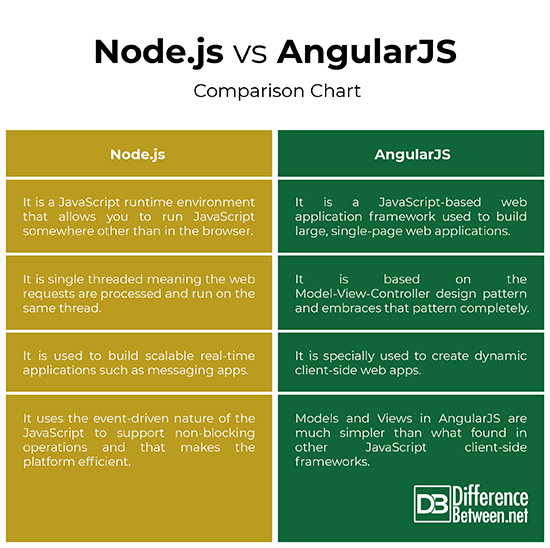Difference Between Node.js and AngularJS
The world of web development has evolved exponentially over the years. The software methodologies and techniques that were considered cutting-edge back then have become obsolete or upgraded significantly.
For example, when innovative technologies like Node.js, AngularJS, and MongoDB started emerging in the world of web development, they were considered too advanced for most serious software projects.
As the technologies matured, developers and software architects started to see great potential in these technologies. Applications written using frameworks such as AngularJS are much robust and faster than conventional web applications and they provide a much better user experience. JavaScript frameworks have made great sides in functionality and reliability over time.
JavaScript transformed web application development after Google released its Chrome web browser along with its V8 JavaScript engine which made JavaScript run so much faster, it almost started a revolution in the web development ecosystem.
Node.js was one of the first products that came out of the revolution. It immediately made strides thanks to its powerful yet elegant module system that allowed developers to extend the platform freely using third-party modules.
Then MongoDB came to the picture which started to gain traction by giving developers the flexibility to deal with more complex data. The popularity of modern web browsers created a new era of JavaScript frontend frameworks. This is where AngularJS comes to the picture.

What is AngularJS?
AngularJS, backed by Google, is one of the most popular and widely used JavaScript-based web application frameworks. It’s an open-source client-side web application development framework that uses the MVC (Model-View-Controller) design pattern and embraces the pattern completely. It’s a structural framework written in JavaScript with a reduced jQuery library that makes it easy to implement structured and well-designed web pages and applications. It’s used for developing single-page applications and applications that have a clear separation between their functional layers. Not only it provides the functionality to handle user input in the browser it also controls how elements are displayed in the browser view. One of the biggest advantages of AngularJS over other client-side frameworks is its concept of services.
What is Node.js?
Node.js is a JavaScript runtime environment based on Google’s V8 JavaScript engine that executes JavaScript code outside the browser. It helps developers build non-blocking units of code so that they could get the most of the system resources to create more responsive applications. The idea was to write the Node.js code in JavaScript and then the V8 engine compiles it into machine code ready to be executed. Node’s module system enables developers to extend the platform using third-party modules to achieve maximum functionality. Node.js simply allows the developers to use every open-source JavaScript project on the server the same as on the client browser which allows for better and tighter integration between the web server and the supporting web application scripts.

Difference between Node.js and AngularJS
-
Basics of Node.js Vs. AngularJS
– Node.js is a JavaScript runtime environment based on Google’s V8 JavaScript engine that is used for building server-side applications written in JavaScript language. It is designed for writing scalable web applications, mostly web servers, but mobile app development is also possible. AngularJS, on the other hand, is a JavaScript-based client-side framework written in JavaScript with a reduced jQuery library that makes it easy to build structured applications that run well on any desktop or mobile platform. It’s one of the most popular JavaScript web application frameworks for building dynamic web applications.
-
Architecture of Node.js Vs. AngularJS
– Node.js is an open-source runtime environment for developing server-side applications that follows Single Threaded Event Loop architecture. This means Node.js in single threaded meaning rather than having multiple threads waiting to process web requests, the requests are run on the same thread with even shared resources. AngularJS is based on the Model-View-Controller architecture in which the layers are separated into three types of objects – Model, View, and Controller – with each handling their own tasks. Model controls data manipulation, view handles the visual part, and the controller controls the interactions between the Model and view.
-
Use of Node.js Vs. AngularJS
– Node.js uses non-blocking, event-driven I/O to develop data-extensive real time applications that run effectively across distributed devices. It acts as an efficient and responsive web server to write both server-side and client-side scripts in JavaScript, along with the scripts written in other languages. It is used to build real-time applications such as messaging apps. AngularJS is written in JavaScript and is used to build large, single-page web applications using HTML as the template language. It allows you to extend the capabilities of HTML using its powerful scope mechanism. It has a simple method for data binding that simplifies some processes.
Node.js vs. AngularJS: Comparison Chart

Summary of Node.js Vs. AngularJS
In a nutshell, Node.js is a JavaScript execution engine capable of running complex JavaScript applications that are simple yet highly efficient, whereas AngularJS is a JavaScript framework used to build dynamic web applications that run well on any desktop or mobile platform. Node.js is a runtime environment, sort of a platform that enables you to run JavaScript somewhere other than in the web browser, whereas AngularJS is an open-source web application framework written in JavaScript and is used to create large, single-page applications using the MVC design pattern.
In short, both are widely used JavaScript technologies that make the foundation of today’s web development ecosystem.
- Difference Between Caucus and Primary - June 18, 2024
- Difference Between PPO and POS - May 30, 2024
- Difference Between RFID and NFC - May 28, 2024
Search DifferenceBetween.net :
Leave a Response
References :
[0]Image credit: https://www.flickr.com/photos/piervix/9177391160
[1]Image credit: https://upload.wikimedia.org/wikipedia/commons/thumb/c/ca/AngularJS_logo.svg/500px-AngularJS_logo.svg.png
[2]Haviv, Amos Q. MEAN Web Development. Birmingham: Packt Publishing, 2014. Print
[3]Syed, Basarat. Beginning Node.js. NYC: Apress, 2014. Print
[4]Dayley, Brad. Node.js, MongoDB, and AngularJS Web Development. Boston: Addison-Wesley, 2014. Print
[5]Williamson, Ken. Learning AngularJS: A Guide to AngularJS Development. Sebastopol, California: O'Reilly Media, 2015. Print
